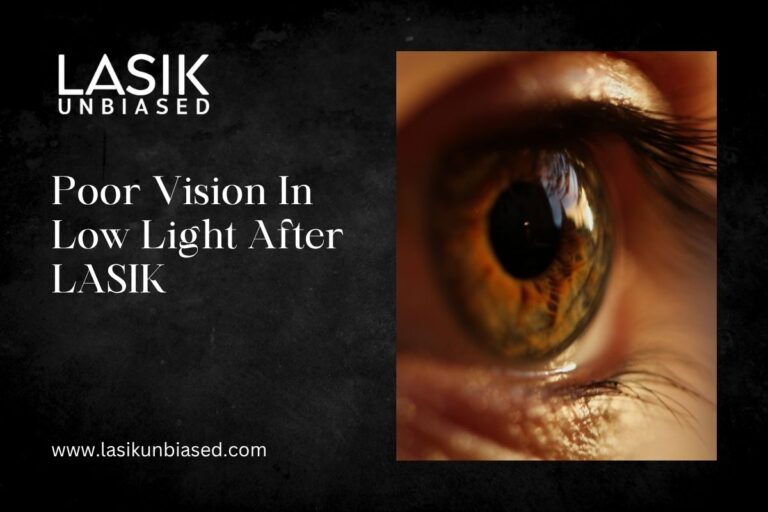Poor vision in low light after LASIK, often called night vision disturbances, can include symptoms like glare, halos, starbursts, and difficulty seeing in dim environments.
Although these effects are typically short-lived, knowing their causes and possible remedies can help you manage and enhance your night vision after surgery.
LASIK surgery has transformed the lives of millions, freeing many from glasses and contacts. But if you’re struggling to see clearly at night or in dimly lit rooms after your procedure, you’re not alone. Let’s break down why this happens, what symptoms to watch for, and how you can address these challenges.
What Contributes to Poor Low-Light Vision After LASIK?
Corneal Reshaping and Light Distortion
LASIK works by reshaping your cornea to correct vision problems like nearsightedness, farsightedness, and astigmatism. However, even small changes in corneal shape after surgery can scatter light, leading to glare, halos, and reduced contrast sensitivity in low-light settings. This is especially noticeable at night, when your eyes rely more on subtle differences in light and shadow.
Pupil Size and Night Vision
Your pupils naturally dilate in darkness to let in more light. If your pupils expand beyond the area of the cornea that was treated during LASIK, light entering through the untreated peripheral cornea can cause visual distortions like halos and starbursts. Individuals with larger pupils are more prone to experiencing these problems.
Healing and Higher-Order Aberrations
During the healing process, your cornea may temporarily be uneven or dry, both of which can worsen night vision. Higher-order aberrations—tiny imperfections not correctable with glasses—may also become more noticeable after surgery, especially in low light.
Typical Signs of Reduced Low-Light Vision Following LASIK
If you’re struggling with night vision following LASIK, you might notice:
- Halos: Bright rings around lights, such as street lamps or headlights.
- Glare: Increased sensitivity to bright lights, making night driving uncomfortable.
- Starbursts: Spiky rays radiating from lights, especially at night.
- Blurry Vision: Difficulty seeing details or shapes in dim environments.
- Poor Contrast Sensitivity: Trouble distinguishing between objects with similar colours or brightness.
These symptoms tend to be most prominent in the weeks right after surgery and usually get better as your eyes recover.
How Long Does Poor Night Vision Last After LASIK?
For most patients, night vision disturbances are temporary. The majority notice significant improvement within three to six months as the cornea heals and your visual system adapts to the changes in how light is processed. However, a small number of people may experience persistent issues that require further evaluation or treatment.
Factors That Influence Night Vision After LASIK
Understanding why some people experience more pronounced low-light vision problems can help set realistic expectations:
- Pre-existing vision conditions: Those with significant refractive errors or requiring larger corrections may be more likely to experience changes in night vision.
- Pupil size: Having larger pupils can heighten the likelihood of experiencing halos and glare in dim lighting.
- Corneal thickness and healing: Thinner corneas or irregular healing can contribute to persistent symptoms.
Modern techniques like wavefront- and topography-guided LASIK have reduced the risk of night vision problems by customising treatment to each eye’s unique shape and imperfections.
Managing and Improving Poor Night Vision After LASIK
Follow Post-Operative Care Instructions
Strictly following your surgeon’s instructions—using prescribed eye drops, attending follow-up appointments, and avoiding eye rubbing—can help your eyes heal smoothly and reduce night vision issues.
Keep Your Eyes Hydrated
Dry eyes frequently occur after LASIK and can intensify night vision problems. Use lubricating eye drops as recommended and stay hydrated to support healing.
Protect Your Eyes from Bright Lights
Wear sunglasses outdoors and consider blue light-blocking glasses for screen time to reduce discomfort and glare.
Limit Nighttime Driving Early On
If you experience significant halos or glare, avoid driving at night until your vision stabilises. This is usually temporary, but safety comes first.
Use Anti-Reflective Lenses
If you still need glasses for certain tasks, choose lenses with anti-reflective coatings to reduce glare and improve comfort in low-light settings.
When to Seek Help for Persistent Night Vision Problems?
Most night vision issues tend to get better with time, but you should contact your eye doctor if:
- Symptoms persist or worsen beyond six months
- You notice sudden changes in vision, severe pain, or redness
- Night vision problems significantly impact your daily life
Your surgeon may recommend additional treatments, such as:
- Short-term use of medicated drops to constrict the pupil and reduce halos, though this isn’t commonly used long-term due to potential side effects
- Special contact lenses to mask irregularities on the cornea
- Further laser enhancements, if residual refractive errors are detected
Advances in LASIK Technology and Night Vision
Modern LASIK has evolved significantly. Techniques like wavefront-guided and topography-guided LASIK allow for highly personalised treatments, reducing the risk of low-light vision problems by addressing higher-order aberrations and matching the treatment zone to your pupil size.
If you’re considering LASIK, ask your surgeon about these advanced options and discuss your night vision concerns during your pre-surgical evaluation.
Tips to Support Night Vision Recovery After LASIK
- Give your eyes time to heal: Most symptoms gradually disappear within a few weeks to a few months.
- Avoid excessive screen time in the dark: This can strain your eyes and worsen symptoms.
- Use prescribed lubricating drops: Keeping your eyes moist supports healing and comfort.
- Attend all follow-up appointments: Your surgeon can monitor healing and address any concerns early.
Key Takeaways: Poor Vision in Low Light After LASIK
- Night vision disturbances after LASIK are common but usually temporary.
- Symptoms include halos, glare, starbursts, blurry vision, and poor contrast sensitivity.
- As your eyes recover, most individuals notice improvement within a few months.
- Advancements in LASIK technology have lowered the chances of experiencing long-term night vision issues.
- If symptoms persist or worsen, consult your eye doctor for personalised solutions.
Poor vision in low light after LASIK can be unsettling, but for most, it’s a temporary part of the healing journey. By understanding the causes, following your surgeon’s advice, and keeping up with post-operative care, you can support your recovery and enjoy the full benefits of your new vision.
If you have ongoing concerns, don’t hesitate to reach out to your eye care provider for guidance and support.
Common Questions About Experiencing Poor Vision in Low Light After LASIK
Is poor night vision after LASIK permanent?
For most people, night vision disturbances are temporary and improve as the eyes heal. Only a small percentage experience long-term issues.
Can LASIK improve night vision in the long run?
Yes, some patients report improved night vision after healing, particularly if they had significant refractive errors or wore glasses with distortions before surgery. Modern techniques like wavefront-guided LASIK can also reduce certain visual imperfections that may have affected night vision.
What if my symptoms don’t improve?
If symptoms continue, make sure to have your eye doctor assess them. Additional treatments or enhancements may be available.


